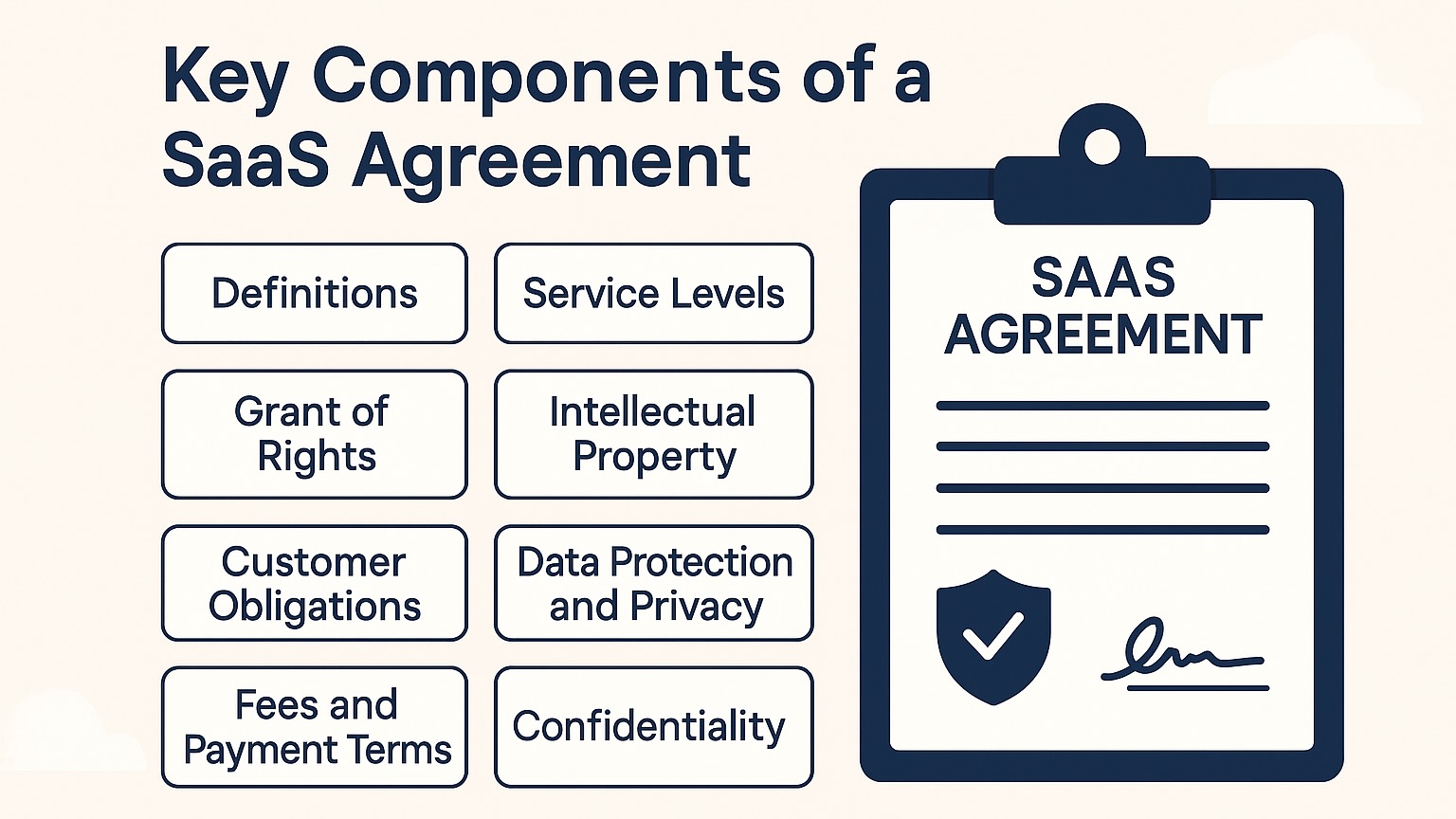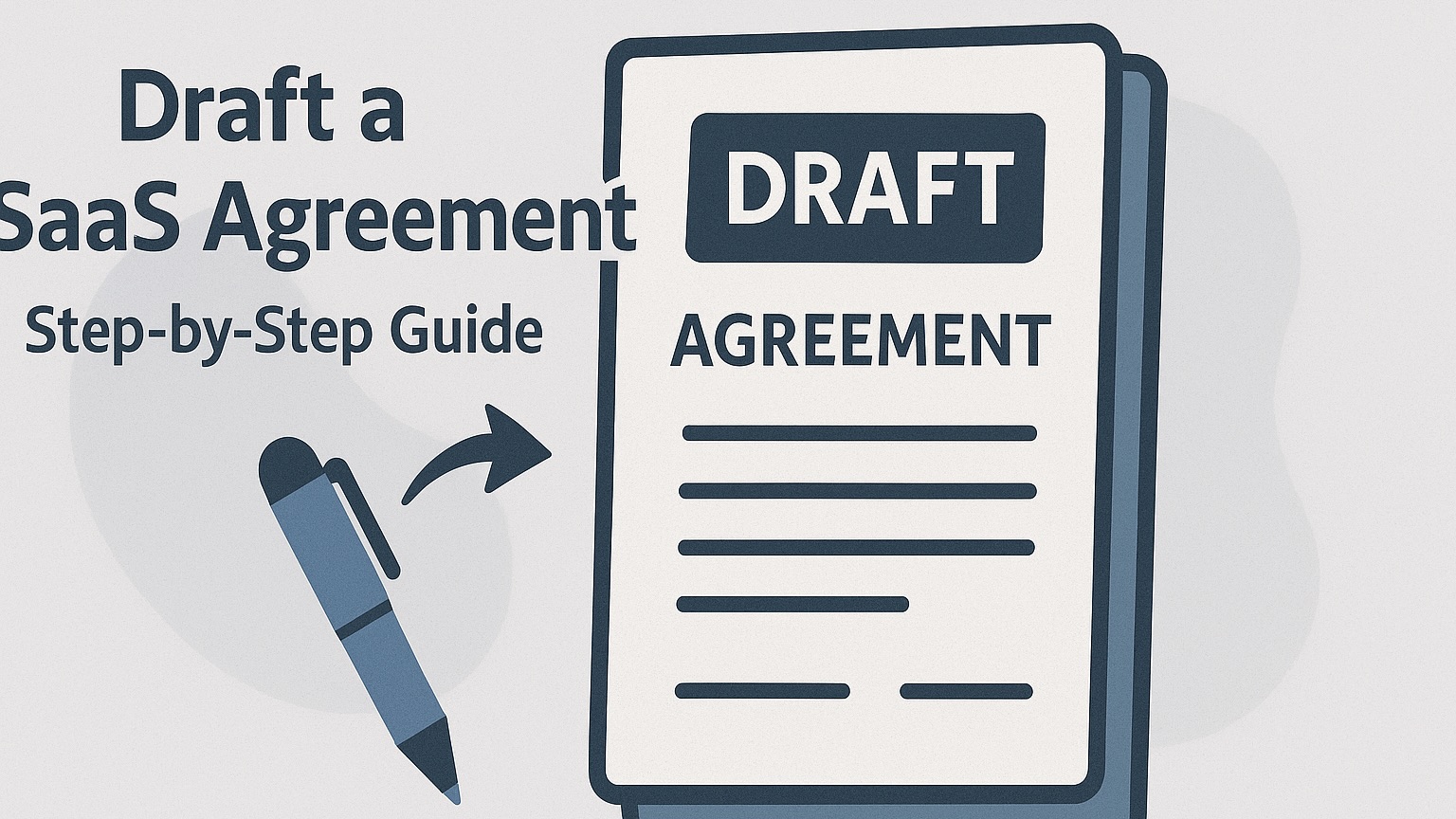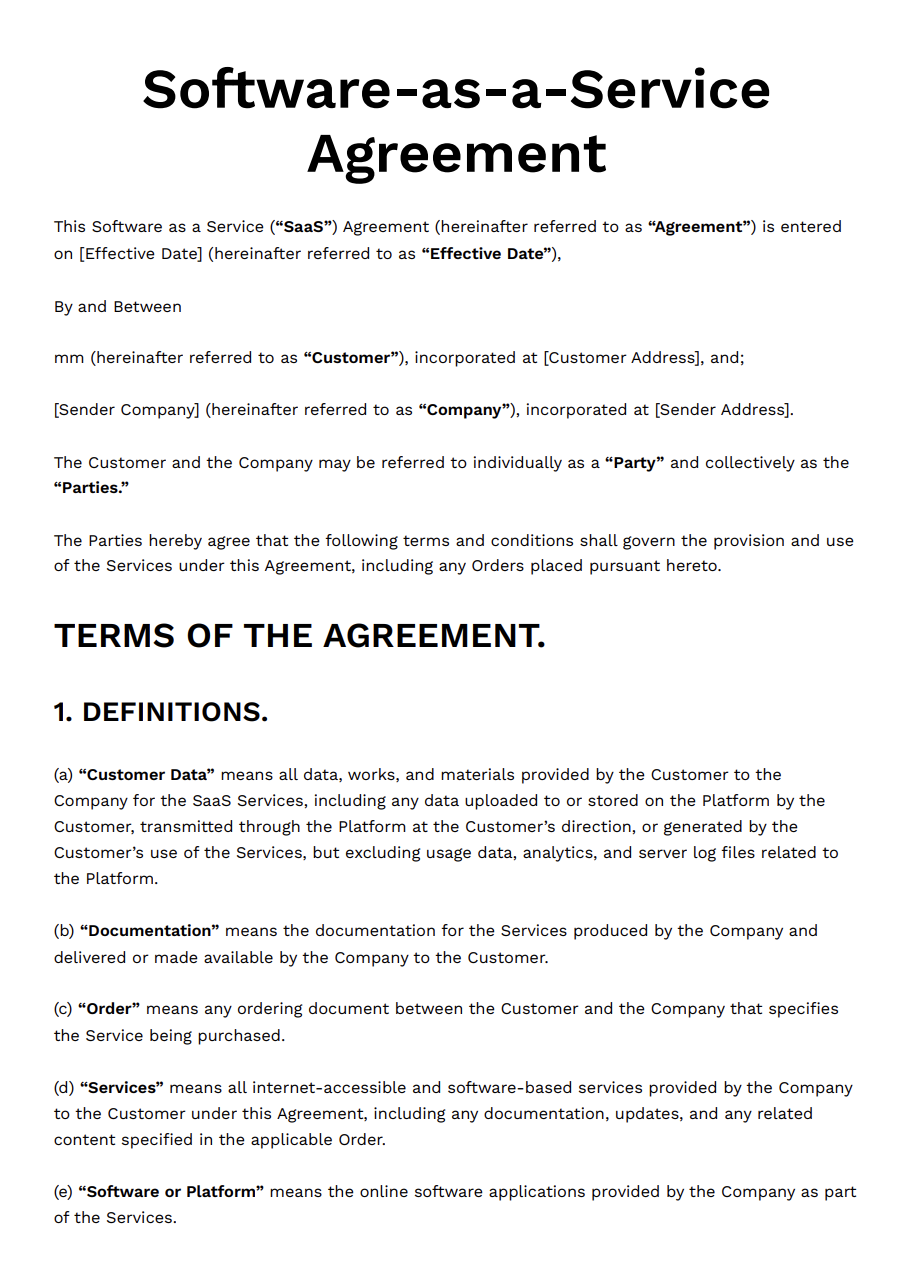2025 SaaS agreement guide: what, why and how to draft

Table of Contents
- 1. Introduction
- 2. What Is a SaaS Agreement?
- 3. When Do You Need a SaaS Agreement?
- 4. Key Components of a SaaS Agreement
- 5. How to Draft a SaaS Agreement (Step-by-Step Guide)
- 6. Drafting Tips and Best Practices
- 7. Resources
- 8. Conclusion
1. Introduction
1.1 What is a SaaS Agreement?
A SaaS agreement is a legal contract between a software provider and a customer that outlines the terms for using cloud-based software. The agreement defines responsibilities, user rights, data handling, and service expectations.
1.2 Why It Matters for SaaS Businesses
A strong SaaS contract minimizes risk, builds trust, and supports scalable growth. It helps protect your business against legal disputes, outlines service obligations, and ensures compliance with data protection laws. For B2B SaaS agreements, where clients expect enterprise-grade assurances, having a well-drafted contract is crucial to closing deals and avoiding liability.
1.3 Who This Guide Is For
This guide is designed for:
- Founders building SaaS products and looking to secure early customer agreements
- Solo developers moving from side projects to monetized apps
- Product teams ensuring terms align with backend capabilities and customer commitments
Whether you're drafting your first contract or refining an existing one, this guide gives you the clarity and tools to create agreements that work in the real world.
2. What Is a SaaS Agreement?
2.1 Definition and Purpose
A SaaS agreement is a contract between a software company and a customer. It explains how the customer can use the software, what the company will provide, and what rules both sides must follow. This type of agreement is common for software that runs online and is paid for every month or year.
The goal is to protect both the business and the customer. It makes sure the customer knows what they’re getting and helps the company avoid problems if things go wrong.
2.2 Key Differences from Traditional Software License Agreements
Here’s how a SaaS contract differs from a traditional software license:
| Feature | Traditional Software License | SaaS Agreement |
|---|---|---|
| Delivery | Installed locally | Accessed via the cloud |
| Payment Model | One-time license fee | Recurring subscription |
| Ownership | User owns a copy | Provider retains ownership |
| Maintenance | Manual updates by user | Automatic updates by provider |
| Data Control | Stored locally | Hosted by the provider |
| Access Rights | Broad usage rights | Controlled, time-bound access |
Because SaaS is delivered and maintained online, agreements must include terms specific to uptime guarantees, support levels, and data handling. These concerns don't typically arise in offline software models, making SaaS agreements more dynamic and detailed.
3. When Do You Need a SaaS Agreement?
3.1 B2B SaaS vs. Self-Serve SaaS
If your software is made for businesses, also known as B2B SaaS, then a formal SaaS agreement is almost always required. Business customers often expect written terms before using your service. These terms help set clear rules and avoid confusion.
For self-serve SaaS, where users sign up online without talking to sales, you may rely on online terms and conditions. However, if you collect sensitive data or charge for the service, a full SaaS agreement still adds protection.
3.2 Signs You Need a Formal Agreement
You should create a SaaS agreement when:
- Customers ask for legal terms
- You handle personal or company data
- You offer paid plans or custom services
- You sell to large companies or government groups
- You provide service guarantees or support levels
These situations bring more legal risk. A clear agreement helps protect your company.
3.3 Reducing Risk for Your Business
A SaaS agreement reduces risk by explaining who is responsible for what. It limits your legal duties, sets payment rules, and explains what happens if things go wrong. If a customer has a complaint or wants to leave, the agreement shows what is fair.
For B2B services, the stakes are higher. Business clients may lose money if your service fails. A written SaaS contract shows that you take these risks seriously and that your company is prepared.
4. Key Components of a SaaS Agreement

A strong SaaS agreement includes clear sections that explain the rights and duties of both sides. Below is a brief synopsis of each key component.
4.1 Definitions
This section explains key terms used in the agreement. Common terms include:
- Service: The software and features you provide
- Customer Data: Any data uploaded or created by the user
- Downtime: When the service is not working or not available
These definitions help avoid confusion and keep everyone on the same page.
4.2 Grant of Rights
This part explains what the customer can and cannot do with the software. It usually includes:
- The right to access and use the service
- Limits on how many users can use it
- A reminder that the customer does not own the software
This helps protect the provider’s rights and ensures fair use.
4.3 Customer Obligations
The agreement should list what the customer is expected to do. This may include:
- Keeping login details private
- Following usage rules
- Not using the service in harmful ways
This section helps prevent misuse of the software.
4.4 Fees and Payment Terms
This explains how much the customer pays and when. It often includes:
- Pricing structure (monthly, yearly, etc.)
- Payment due dates
- What happens if a payment is late
Clear payment terms help avoid billing problems.
4.5 Service Levels
This part sets out what level of service the provider will give. It may include:
- Uptime targets (for example, 99.9% available)
- Support response times
- When updates or fixes will happen
These rules help manage customer expectations.
4.6 Intellectual Property
This section makes clear that the company owns the software. It should also explain:
- Who owns data or content added by users
- That users do not gain any rights to the code
This helps protect your business and its products.
4.7 Data Protection and Privacy
This explains how customer data is handled. It may cover:
- Data security practices
- Rules for following privacy laws like GDPR
- What happens in case of a data breach
This part is important for trust and legal safety.
4.8 Confidentiality
This part promises that both sides will keep private information secret. It helps protect business plans, pricing, and other sensitive data.
4.9 Term and Termination
This section explains how long the agreement lasts and how it can end. It may include:
- Start and end dates
- Rules for renewing or cancelling
- What happens to data after termination
This keeps both sides clear on their rights.
4.10 Limitation of Liability
This part limits how much the provider has to pay if something goes wrong. It protects against big losses and keeps risks reasonable.
4.11 Indemnification
This explains who is responsible if a third party makes a legal claim. Usually, each side agrees to protect the other if they cause legal trouble.
4.12 Dispute Resolution
This part covers how to handle disagreements. It often includes:
- Which country’s laws apply
- Whether disputes go to court or arbitration
Clear rules here help avoid long and costly legal fights.
You can generate a SaaS agreement in under 15 minutes with our easy-to-use contract builder. No login required
5. How to Draft a SaaS Agreement (Step-by-Step Guide)

5.1 Determine Key Terms
Start by writing down the key parts of your service:
- What features you offer
- How users will access them
- What the billing model is (monthly or yearly)
- Payment terms, such as due dates and late fees
Clear terms reduce confusion and make your business easier to manage.
5.2 Describe the Service
Explain what the customer will get. This can include:
- Software functions
- Limits on users or data
- Support options
Avoid vague words. Be simple and direct.
5.3 Support and Maintenance Terms
Write out your rules for:
- Fixing bugs
- Updating features
- Support response times
If your team takes weekends off, say so clearly.
5.4 Customization and Tailoring
If you offer custom services or special deals, include these in the agreement. Make sure they match what was promised during the sales process.
This part is often needed for large B2B clients who ask for changes.
5.5 Legal Review and Risk Management
Even a simple agreement should be reviewed by a legal expert. A lawyer can:
- Check for missing parts
- Make sure your terms follow local laws
- Suggest better ways to reduce risk
This small step can save you big trouble later.
5.6 Testing and Feedback
Once you have a draft, test it:
- Show it to team members
- Ask a few trusted users to review it
- Adjust anything that causes confusion
Make changes before you share it widely. A clear agreement shows that you care about being honest and fair.
6. Drafting Tips and Best Practices
6.1 Use Clear, Simple Language
Avoid long or complex sentences. Use plain words that your users can understand. Even when dealing with legal topics, it's better to explain things simply. For example, say “You must pay on time” instead of “Timely remittance of fees is required.”
Clear language builds trust and avoids misunderstanding.
6.2 Match Terms to Your Product
Make sure the agreement reflects how your product actually works. If your app allows unlimited users, the contract should not limit user numbers. If your support is only through email, do not promise phone calls.
Keeping your terms aligned with your features helps manage customer expectations.
6.3 Review Regularly
Your service may change over time. When you add new features, raise prices, or update your support plan, your agreement may also need changes. Set a regular time to review and update it, such as every six months or after big releases.
6.4 When to Consult a Lawyer
If your product handles personal data, involves high-value contracts, or serves global customers, a lawyer’s help is important. Lawyers can:
- Help with GDPR and privacy rules
- Spot hidden legal risks
- Review your liability limits
Good legal help now can prevent expensive mistakes later.
7. Resources
7.1 Recommended Template Sources
If you’re not sure where to start, using a trusted template can save time. Here are a few places that offer reliable SaaS agreement templates:
- SaaSGree: Generate SaaS contract from templates with contract builder.
- Cooley GO: Offers free templates for startups, including SaaS terms.
- LawDepot: Lets you build custom contracts online.
These can give you a starting point, but remember to adjust them to match your own product.
7.2 Tools for Contract Management and E-Signature
Once you have your agreement ready, you’ll need a way to send, sign, and store it. These tools help:
| Tool | Main Use |
|---|---|
| DocuSign | Secure online signatures |
| HelloSign | Easy e-signing with team features |
| Contractbook | All-in-one contract management |
Using these tools helps you work faster and keeps your agreements organized and safe.
8. Conclusion
A strong SaaS agreement is more than just a legal document. It is a clear promise between you and your customers. It shows what your service includes, how you handle data, and how both sides should act if something goes wrong.
For B2B companies, having a written agreement is not just helpful—it is expected. It helps close deals, builds trust, and reduces risk.
Keep your agreement simple, honest, and up to date. Review it as your product grows, and don’t be afraid to ask a lawyer for help when needed.
You can Generate a SaaS agreement in under 15 minutes with our easy-to-use contract builder.
